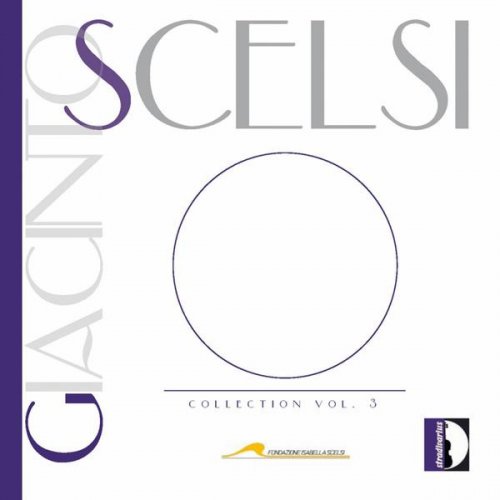
Tito Ceccherini, RAI National Symphony Orchestra - Giacinto Scelsi: Collection, Vol. 3 (2009)
BAND/ARTIST: Tito Ceccherini, RAI National Symphony Orchestra
- Title: Giacinto Scelsi: Collection, Vol. 3
- Year Of Release: 2009
- Label: Stradivarius
- Genre: Classical
- Quality: FLAC (tracks+.cue,log)
- Total Time: 64:00
- Total Size: 248 MB
- WebSite: Album Preview
Tracklist:
[01-04] Aiôn (1961)
quattro episodi di una giornata di Brahma
for six percussionists, timpani and orchestra
[05] Hymnos (1963)
for organ and two orchestras
[06-09] Quattro pezzi per orchestra (1959)
(Each on a note)
[10] Ballata (1945)
for cello and orchestra
[01-04] Aiôn (1961)
quattro episodi di una giornata di Brahma
for six percussionists, timpani and orchestra
[05] Hymnos (1963)
for organ and two orchestras
[06-09] Quattro pezzi per orchestra (1959)
(Each on a note)
[10] Ballata (1945)
for cello and orchestra
The brooding music and cryptic mysticism of Giacinto Scelsi combine to make him a legend among modern composers, with all the potential to provoke skepticism and misunderstanding that usually attends legends. Disputes over the authorship of some of his dictated works and puzzlement over his reclusiveness and hermetic religious thought make it easy to write Scelsi off as an eccentric who staked his reputation on personal revelations, rather than on musical genius. However, anyone who has followed Stradivarius' multi-volume survey of Scelsi's music may have found much substance in his works, or at least enough to dispel most doubts. Aiôn for percussion, timpani, and orchestra, subtitled, "Four Episodes in a Day of Brahma," leads off the third volume of the series, and its expansive drones and intense microtonal layers make it an unsettling listening experiences. Yet this music is strangely compelling for its air of anticipation and hypnotic stasis; despite the emergence of patterns that periodically suggest activity, the sustained passages of close dissonances create an unresolved state. Hymnos for organ and two orchestras is similar to Aiôn in its slowly evolving sonorities, though it is more active rhythmically and harmonically denser. Quattro pezzi per orchestra is one of Scelsi's most frequently performed works, and its appearance on this program makes it seem like a schema of the ideas presented in later works. Ballata for cello and orchestra concludes the program with a change of direction toward more conventional modern composition, for the cello soloist provides a distinctive melodic quality lacking in the earlier pieces, and the orchestra communicates in a language not too far removed from Alban Berg or Arnold Schoenberg. The committed performances of cellist Francesco Dillon and the Orchestra Sinfonica Nazionale della RAI, conducted by Tito Ceccherini, go a long way in making Scelsi's music intelligible and appealing, and even if his life remains a matter of controversy, at least his music is well-served by this recording.
Download Link Isra.Cloud
Tito Ceccherini, RAI National Symphony Orchestra - Giacinto Scelsi: Collection, Vol. 3 (2009)
My blog
Tito Ceccherini, RAI National Symphony Orchestra - Giacinto Scelsi: Collection, Vol. 3 (2009)
My blog
Classical | FLAC / APE | CD-Rip
As a ISRA.CLOUD's PREMIUM member you will have the following benefits:
- Unlimited high speed downloads
- Download directly without waiting time
- Unlimited parallel downloads
- Support for download accelerators
- No advertising
- Resume broken downloads


